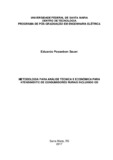| dc.creator | Sauer, Eduardo Possebon | |
| dc.date.accessioned | 2018-10-31T17:55:07Z | |
| dc.date.available | 2018-10-31T17:55:07Z | |
| dc.date.issued | 2017-09-25 | |
| dc.identifier.uri | http://repositorio.ufsm.br/handle/1/14715 | |
| dc.description.abstract | This work presents a methodology for technical and economic analysis for the attendance of residential loads, with different demands and located in the rural area, with the use of distributed generation sources that can work isolated, connected, or even in a mixed way, with the conventional electric power grid, in other words, partially isolated and partially connected to the power network. Through the methodology, it is possible to reduce generation costs and define the best network topology, as well as the positioning of distributed generation sources. The methodology consists of using the data related to the distributed generation sources and the data related to the distribution network, in order to find the minimum net present value between the sources and the optimal network topology. Different sources of distributed generation will be evaluated in three different scenarios, to be then calculated the generation source to be used among the analyzed ones and for the best possible configuration to be found. The solutions demonstrate that just as the type of land affects decisions, the type of energy source also affects, since its current costs in R$/kWh still differ greatly from one to another. In areas with major impediments, such as rivers and forests, transmission networks tend to suffer drift, since it directly affects the cost. Finally, several aspects are important in a study involving sources of distributed generation, since in a rural area, we find from rivers and hills interfering in the construction of transmission networks, as large pasture fields present themselves to facilitate the construction of their own. Thus, through the methodology employed, the final result is the best network configuration and the best selection of energy source to attend the loads. | eng |
| dc.language | por | por |
| dc.publisher | Universidade Federal de Santa Maria | por |
| dc.rights | Attribution-NonCommercial-NoDerivatives 4.0 International | * |
| dc.rights.uri | http://creativecommons.org/licenses/by-nc-nd/4.0/ | * |
| dc.subject | Geração distribuída | por |
| dc.subject | Zona rural | por |
| dc.subject | HOMER® | por |
| dc.subject | ViPOR® | por |
| dc.subject | Distributed generation | eng |
| dc.subject | Rural area | eng |
| dc.subject | HOMER® | eng |
| dc.subject | ViPOR® | eng |
| dc.title | Metodologia para análise técnica e econômica para atendimento de consumidores rurais incluindo GD | por |
| dc.title.alternative | Methodology for technical and economic analysis for rural consumers including DG | eng |
| dc.type | Dissertação | por |
| dc.description.resumo | Este trabalho apresenta uma metodologia para análise técnica e econômica para o atendimento de cargas residenciais, com diferentes demandas e situadas na zona rural, com a utilização de fontes de geração distribuídas que podem trabalhar isoladas, conectadas ou ainda, de forma mista com a rede convencional de energia elétrica, isto é, parcialmente isolada e parcialmente conectada à rede de energia. Através da metodologia é possível reduzir custos de geração e definir a melhor topologia de rede, assim como o posicionamento das fontes de geração distribuída. A metodologia consiste em utilizar os dados referentes às fontes de geração distribuída e os dados referentes à rede de distribuição, para, através dos custos de suprimento de energia elétrica e dos custos da rede de distribuição, encontrar o valor presente líquido mínimo entre as fontes e a topologia de rede ótima. Diferentes fontes de geração distribuída serão avaliadas em três diferentes cenários, para então ser calculada a fonte de geração a ser utilizada dentre as analisadas e para a melhor configuração possível ser encontrada. As soluções demonstram que, assim como o tipo de terreno afeta as decisões, o tipo de fonte de energia também afeta, pois seus custos atuais em R$/kWh ainda diferem muito de uma para outra. Em terrenos com grandes impedimentos, como rios e florestas, as redes de transmissão tendem a sofrer desvios, uma vez que impacta diretamente no custo. Por fim, diversos aspectos se apresentam importantes em um estudo que envolve fontes de geração distribuída, uma vez que em uma zona rural, encontramos desde rios e colinas interferindo na construção de redes de transmissão, como grandes campos de pastagem se apresentam para facilitar a construção das mesmas. Desta forma, através da metodologia empregada obtém-se como resultado final a melhor configuração de rede e a melhor seleção de fonte de energia para o atendimento das cargas. | por |
| dc.contributor.advisor1 | Bernardon, Daniel Pinheiro | |
| dc.contributor.advisor1Lattes | http://lattes.cnpq.br/6004612278397270 | por |
| dc.contributor.referee1 | Canha, Luciane Neves | |
| dc.contributor.referee1Lattes | http://lattes.cnpq.br/6991878627141193 | por |
| dc.contributor.referee2 | Knak Neto, Nelson | |
| dc.contributor.referee2Lattes | http://lattes.cnpq.br/8117456718259417 | por |
| dc.creator.Lattes | http://lattes.cnpq.br/6684911413357538 | por |
| dc.publisher.country | Brasil | por |
| dc.publisher.department | Engenharia Elétrica | por |
| dc.publisher.initials | UFSM | por |
| dc.publisher.program | Programa de Pós-Graduação em Engenharia Elétrica | por |
| dc.subject.cnpq | CNPQ::ENGENHARIAS::ENGENHARIA ELETRICA | por |
| dc.publisher.unidade | Centro de Tecnologia | por |



